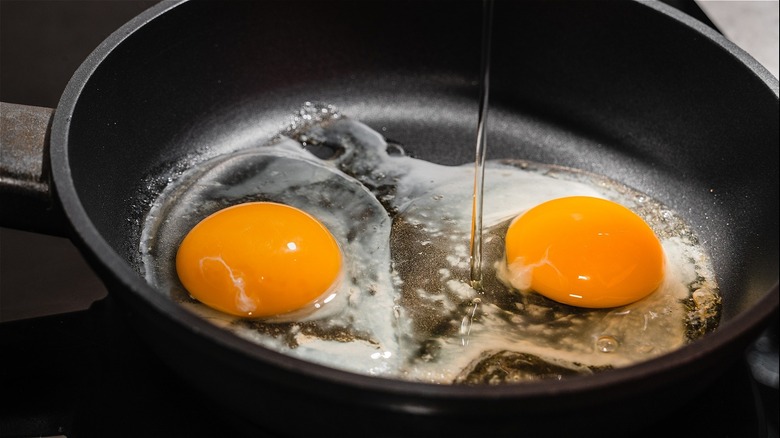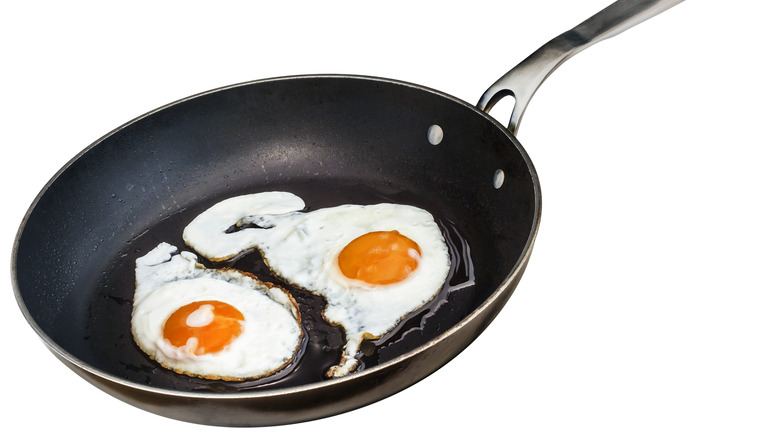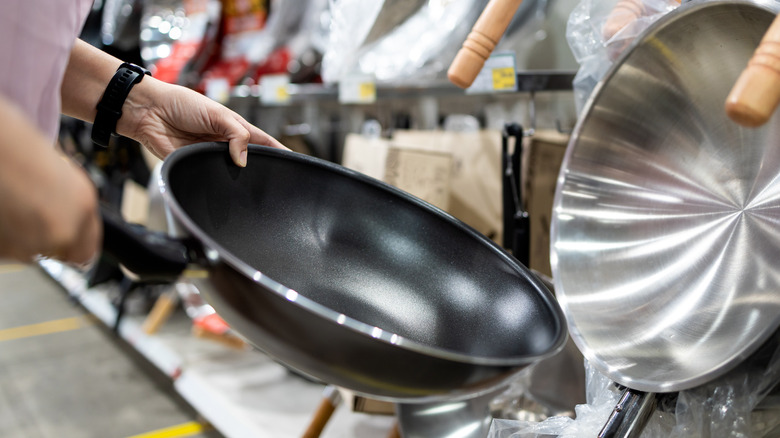The Scary Way Your Nonstick Pans Can Turn Toxic
Humans have a tendency to invent things first and worry about the consequences later. History is rife with examples, but one that seems to keep coming up is Teflon. Teflon is the brand name for the resinous coating that puts the nonstick in many a nonstick pan. It was discovered by accident in 1938 when Dr. Roy J. Plunkett froze a compressed gas called tetrafluoroethylene. To Plunkett's surprise, this had the effect of polymerizing the gas into a "white, waxy solid" that's now known as polytetrafluoroethylene (i.e. polymerized tetrafluoroethylene).
Anything with that many syllables can sound scary. However, Teflon is considered safe when used by reputable companies in the manufacture of nonstick pans. At least, it has been since 2013, when perfluorooctanoic acid (PFOA) stopped being used Teflon's production, according to Robin Miller, a nutritionist, chef, and food writer, whom we consulted in the hopes of getting to the bottom of whether or not it's safe to cook with Teflon-coated nonstick pans. "As much as you love your cherished, time-honored nonstick pans, the coated cookware doesn't last forever," Miller says. "If your pans are warped, discolored, scratched, and/or peeling, it's time to get new equipment."
Teflon coating itself is considered non-toxic, per Live Science. However, that's assuming you're using your cookware as directed on the packaging of your cookware (if you don't still have the packaging, instructions can also be found on the Teflon website). Here's why some experts believe improper use of nonstick pans could potentially render them toxic.
Why you shouldn't use nonstick pans at high-heat temperatures
Using metal utensils on nonstick cookware can wreck the Teflon surface. Even so, ingesting a few Teflon flakes isn't problematic, according to Live Science and Healthline. Like fiber, it passes through your system undigested.
But if you're heating your Teflon-coated nonstick pans to higher temperatures than recommended by the manufacturer, you risk exposure to toxic fumes, according to Dr. Suzanne Fenton, a reproductive endocrinologist at the National Institutes of Environmental Health Sciences in North Carolina (via Live Science). As Teflon begins to break down, some of the gases that are released may be toxic. Despite that PFOA is no longer used in making Teflon, PFOA is often cited as one of these gases.
As you might have already guessed, other experts disagree. In fact, thus far, no clinical study has addressed whether the breakdown of Teflon in nonstick pans may have long-term deleterious affects on humans. What is known, however, is that on rare occasion, exposure to the vapors released from overheating Teflon can cause a short-term condition known as "polymer fume fever," which, as its name implies, is an inflammatory response to exposure to polymer fumes. (This may be why Teflon warns about heating its nonstick pans to temperatures over 500 °F.)
Should you replace your nonstick pans?
If your nonstick pans are starting to show a bit of wear and tear, it might be time to replace them entirely. "Even if your nonstick pans look only slightly weathered, you should replace them every five years," says nutritionist, chef, and food writer Robin Miller. Miller also suggests buying new cookware, rather than trying nonstick sprays to repair chipped or cracked Teflon.
"You may find online solutions, including nonstick repair sprays that promise to revitalize your pans. Those coatings may be more toxic than the pan itself, especially since they degrade over time (and the sprays degrade much faster than your pan's actual coating)," Miller says. "Instead of using multiple repair sprays over the years, invest in higher-quality nonstick cookware. Don't risk your health just to save a buck or two; that's my motto." She recommends using ceramic nonstick cookware, such as GreenPan.


